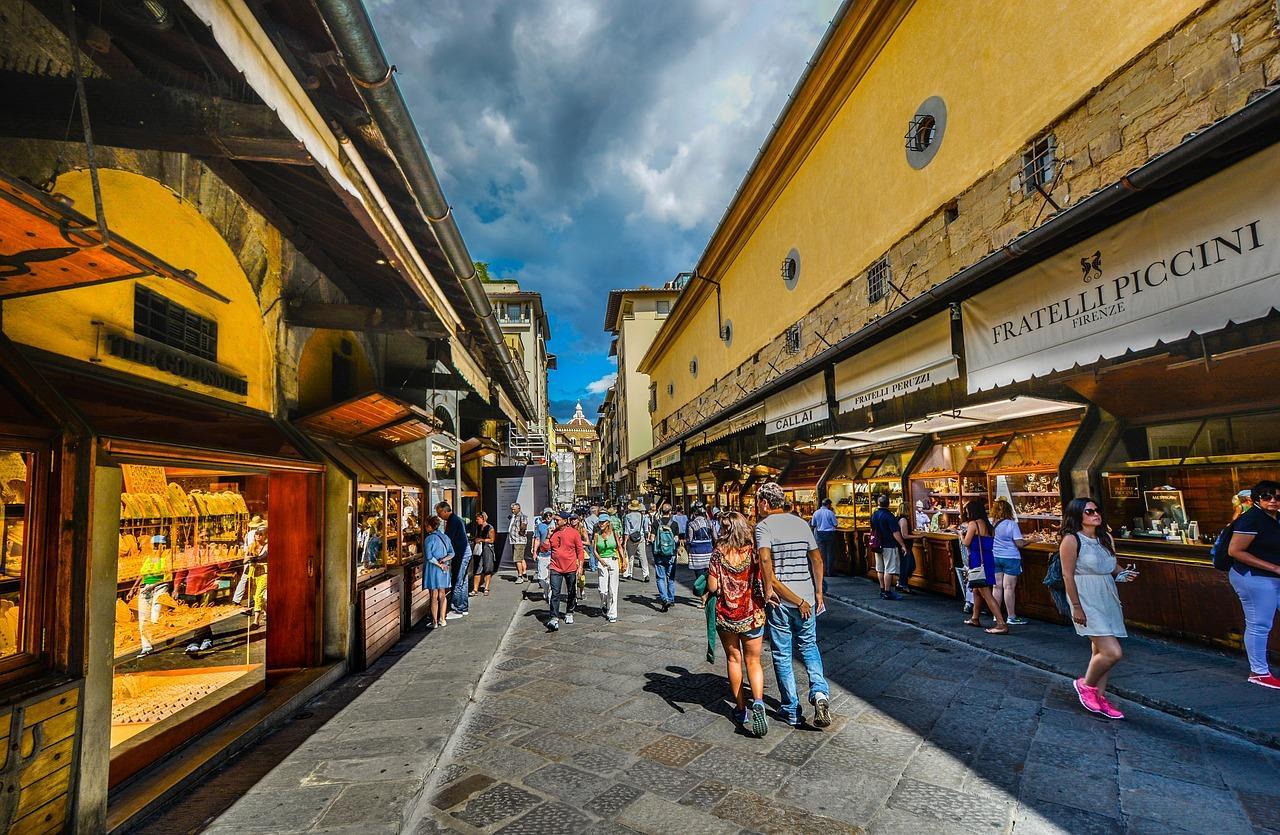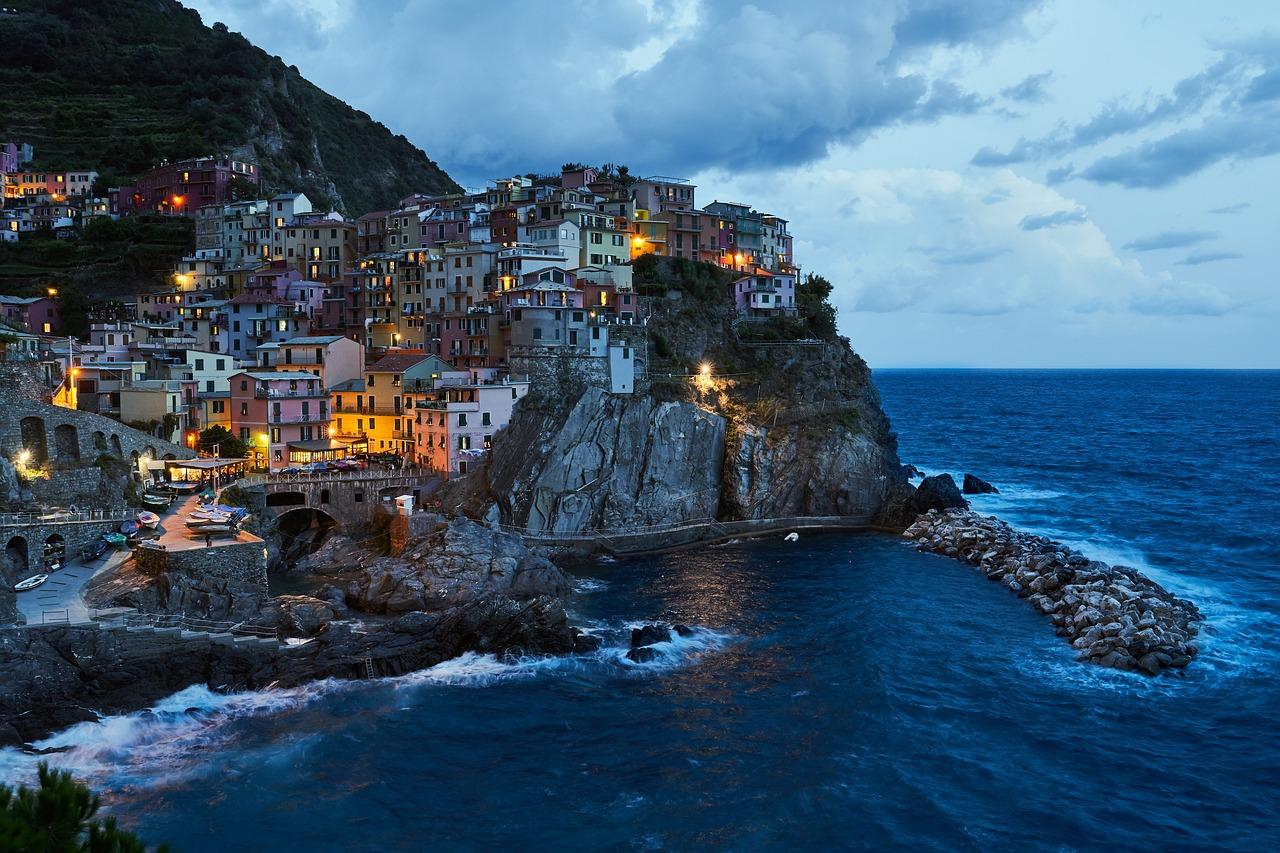Florence Travel Guide
Florence was a centre of medieval European trade and finance and one of the wealthiest cities of that era. It is considered the birthplace of the Renaissance, and has been called “the Athens of the Middle Ages”.
Florence, the enchanting capital of Italy’s Tuscany region, is renowned for its rich artistic and cultural heritage. As the birthplace of the Italian Renaissance, this charming city boasts an impressive collection of world-class art, stunning architecture, and captivating history. Stroll through the city’s narrow, cobbled streets, and you’ll be mesmerized by the stunning sight of the iconic Cathedral of Santa Maria del Fiore, with its striking red-tiled dome designed by Brunelleschi.
Florence is home to the Uffizi Gallery, which houses a treasure trove of masterpieces by famous artists such as Botticelli, Michelangelo, Leonardo da Vinci, and Caravaggio. A visit to the Accademia Gallery, where Michelangelo’s magnificent statue of David resides, is also an unmissable experience. The picturesque Ponte Vecchio, a medieval stone bridge lined with vibrant shops, spans the Arno River, adding to the city’s unmistakable charm.
In addition to its artistic marvels, Florence offers a rich culinary scene with delicious Tuscan cuisine, featuring fresh ingredients, delectable wines, and mouthwatering gelato. The bustling markets, elegant boutiques, and welcoming locals all contribute to the warm, inviting atmosphere that makes Florence an unforgettable destination
Table of Contents
Best Time to Visit Florence
The best season to visit Florence is during the spring and fall, when the weather is mild and pleasant, and the crowds are relatively smaller compared to the peak summer months.
Summer in Florence can be very hot and humid, and large crowds of tourists.
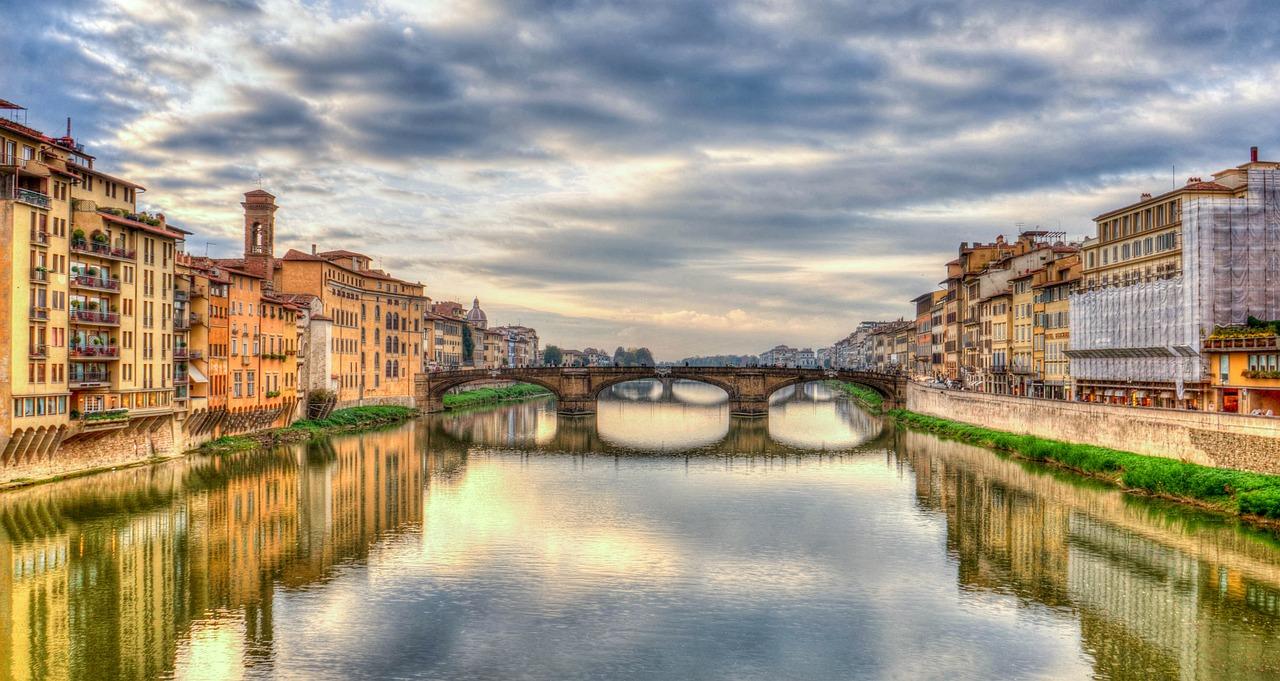
Winter in Florence is typically mild and occasional rain. However, winter can be a great time to enjoy indoor attractions such as museums and galleries, and to experience the festive holiday atmosphere.
Top Attractions
View the Florence Attractions map in the Google Earth link.
- Cathedral of Santa Maria del Fiore
- Uffizi Gallery
- Pitti Palace and Boboli Gardens
- Accademia Gallery and Michelangelo’s David
- Ponte Vecchio
- Palazzo Vecchio and Piazza della Signoria
- Basilica di Santa Croce
- Bargello National Museum
- Medici Chapels
- Piazzale Michelangelo
Cathedral of Santa Maria del Fiore
The heart of Florence is its magnificent Cathedral, also known as the Piazza del Duomo, where you can marvel at the stunning architecture of the Cathedral, the Baptistery, and Giotto’s Campanile.
Founded in 1296, it is the third largest cathedral in the world. The most famous feature is the dome of the cathedral, which is still the largest brick dome in the world. It was constructed using a “fishbone” pattern, with bricks and stones gradually laid from the bottom to the top. you can climb to the top for stunning views of the city.
The octagonal Baptistery is one of the oldest buildings in Florence and features beautiful mosaics and bronze doors.
The interior of the Cathedral is breathtaking, with stunning frescoes, stained glass windows, and intricate marble floors.
The Giotto’s Bell Tower is located next to the Cathedral, the bell tower offers another vantage point for panoramic views of the city.
The Museum of the Opera del Duomo is located nearby and features many of the original sculptures and artwork from the Cathedral, including works by Michelangelo and Donatello.
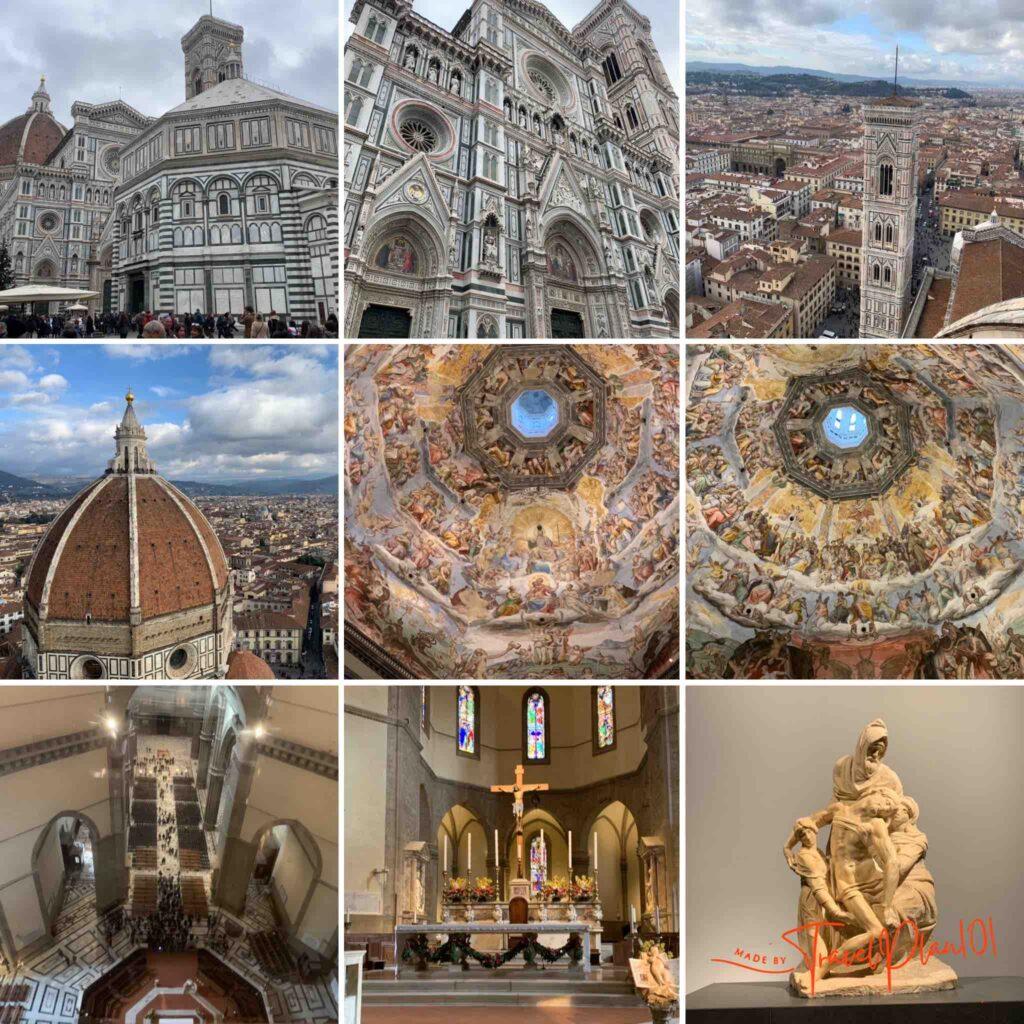
NOTE: To reach Brunelleschi’s Dome, visitors are required to climb 463 steps. No lifts (elevators) are available. The Giotto’s Bell Tower consists of a stairway of 414 steps and there is no lift. The climb is strongly NOT recommended for people with cardiovascular, respiratory diseases, vertigos, claustrophobia, and pregnant women.
Website: https://duomo.firenze.it/en/home/
Ticket Office: https://operaduomofirenze.skiperformance.com/en/store#/en/buy
Ticket Price: Admission to the church interior is free; a combined ticket is required for other areas and is valid for 3 days.
- Brunelleschi Pass (5-attraction pass): €30, including the dome, bell tower, baptistery, museum, and crypt, valid for 3 days. Advance reservation is required for the dome. Recommended if you are comfortable climbing the 463 steps of the Dome.
- Giotto Pass (4-attraction pass): €20, including the bell tower, baptistery, museum, and crypt, valid for 3 days.
- Ghiberti Pass (3-attraction pass): €15, including the baptistery, museum, and crypt, valid for 3 days. Recommend if you are not comfortable climbing steps.
Uffizi Gallery
No trip to Florence is complete without a visit to the Uffizi Gallery, home to some of the world’s most famous Renaissance art, including works by Michelangelo, Botticelli, and da Vinci.
The Uffizi Gallery was originally built to house the Medici family’s art collection, so it’s no surprise that the museum is home to many works by famous Medici artists like Michelangelo, Raphael, and Titian.
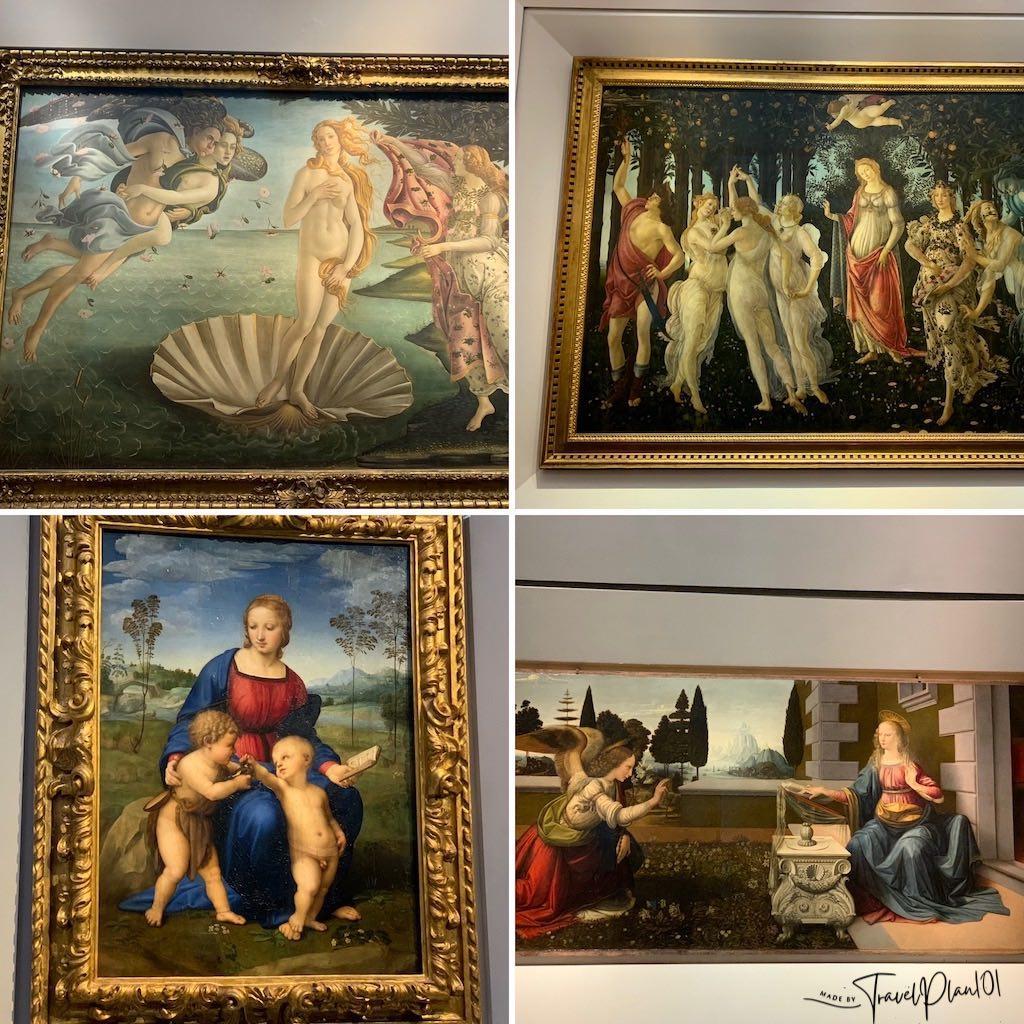
The famous painting “The Birth of Venus” (top-left photo) by Sandro Botticelli is one of the most iconic artworks in the Uffizi Gallery. It depicts the goddess Venus rising from the sea, and it’s a beautiful example of the Renaissance period.
Another Sandro Botticelli’s famous Renaissance painting “Primavera” (Spring) (top-right photo) 1480 features an allegorical scene with mythological figures set in a lush garden. Rich with symbolism, it is believed to represent the arrival of spring, the renewal of nature, and the interplay of love and fertility.
“The Madonna of the Goldfinch” (bottom-left photo) by Raphael (Raffaello Sanzio), 1506; In the center of the painting is the Virgin Mary, who is lovingly watching the young Jesus and the young John the Baptist play. The toy in the hands of the two children is a goldfinch, which is a symbol of the passion of Jesus.
“The Annunciation” (bottom-right photo) is another famous painting in the Uffizi Gallery, this work by Leonardo da Vinci is known for its intricate details and beautiful use of light and shadow.
Website: https://www.uffizi.it/en/
Open Hours:
- Tue – Sun 08:15am – 06:50pm
- close on Mon
- ticket office close at 06:05pm and 06:35pm starts close
Ticket Office: https://www.uffizi.it/en/tickets
Ticket Price:
From March 1st to October 31st
- Regular / Reduced €25 / €2 + online reservation: €4
- PassPartout 5 days: €38 Uffizi + Pitti Palace + Boboli Gardens for 5 consecutive days (Recommend if you plan to visit Pitti Palace and Boboli Gardens)
From November 1st to February 28
- Regular / Reduced €12 / €2 + online reservation: €4
- PassPartout 5 days: €18 Uffizi + Pitti Palace + Boboli Gardens for 5 consecutive days (Recommend if you plan to visit Pitti Palace and Boboli Gardens)
Also check the Pitti Palace and Boboli Gardens below
Pitti Palace and Boboli Gardens
Pitti Palace and Boboli Gardens are two of Florence’s most iconic attractions, offering visitors a fascinating glimpse into the city’s rich history and stunning natural beauty. Pitti Palace, once the residence of the powerful Medici family, is an impressive Renaissance palace that houses several important museums and art collections, including the Palatine Gallery, the Gallery of Modern Art, and the Costume Gallery. Within its walls, you’ll find stunning frescoes, intricate stucco work, and priceless works of art by masters like Raphael, Titian, and Rubens.
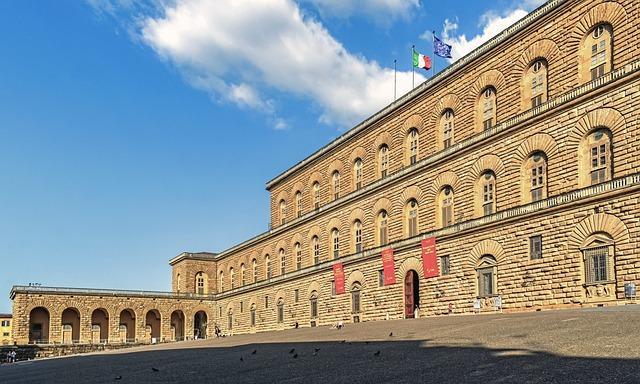
Adjacent to the palace, the Boboli Gardens stretch across 111 acres of beautifully landscaped grounds. This open-air museum features a mix of Renaissance and Baroque styles, with fountains, grottoes, statues, and ancient Roman artifacts scattered throughout. As you wander the gardens’ pathways, you’ll encounter stunning viewpoints offering panoramic vistas of Florence and the surrounding countryside. The Pitti Palace and Boboli Gardens are a must-visit for art lovers, history buffs, and anyone seeking a tranquil escape within the bustling city of Florence.
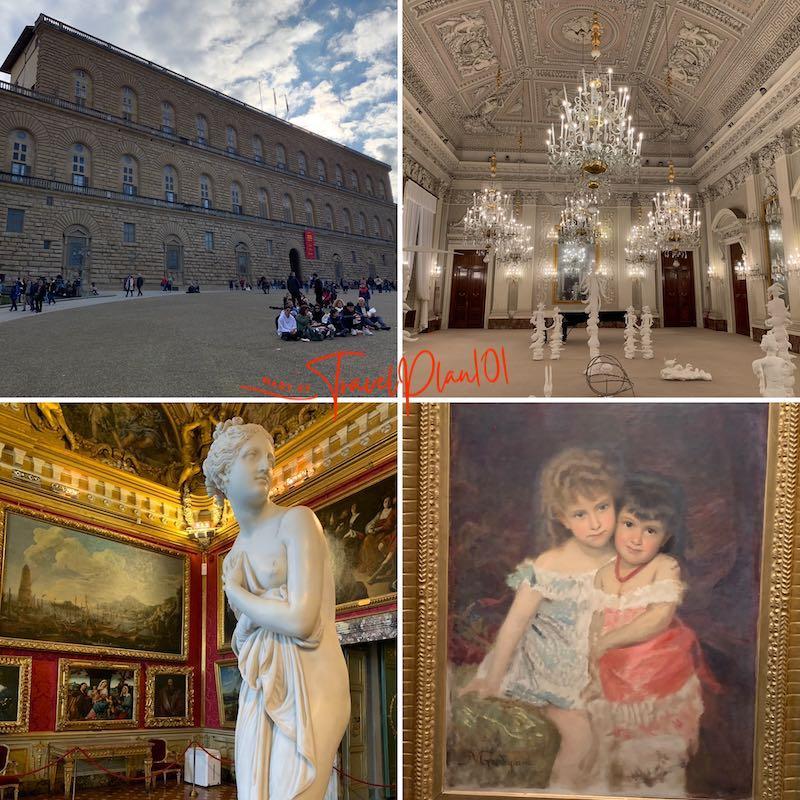
Ticket Office: https://www.uffizi.it/en/tickets (same with Uffizi Gallery)
Ticket Price:
From March 1st to October 31st
- Palazzo Pitti: Regular / Reduced €16 / €2 + Online Reservation €3
- Boboli Garden: Regular / Reduced €10 / €2 + Online Reservation €3
- Combined Palazzo Pitti + Boboli Garden: €22
- PassePartout 5 Days: Uffizi + Palazzo Pitti + Boboli Garden for 5 consecutive days: €38 (Recommend if you also plan to visit Uffizi Gallery)
From November 1st to February 28
- Palazzo Pitti: Regular / Reduced €10 / €2 + Online Reservation €3
- Boboli Garden: Regular / Reduced €6 / €2 + Online Reservation €3
- Combined Palazzo Pitti + Boboli Garden: €14
- PassePartout 5 Days: Uffizi + Palazzo Pitti + Boboli Garden for 5 consecutive days: €18 (Recommend if you also plan to visit Uffizi Gallery)
The Accademia Gallery
The Accademia Gallery has a total of seven exhibition halls, mainly collecting works of sculpture and oil painting from the Renaissance period. Apart from the Uffizi Gallery, this is the second most popular art gallery in Florence. It is recommended to book tickets in advance, otherwise there may be long queues during peak season.
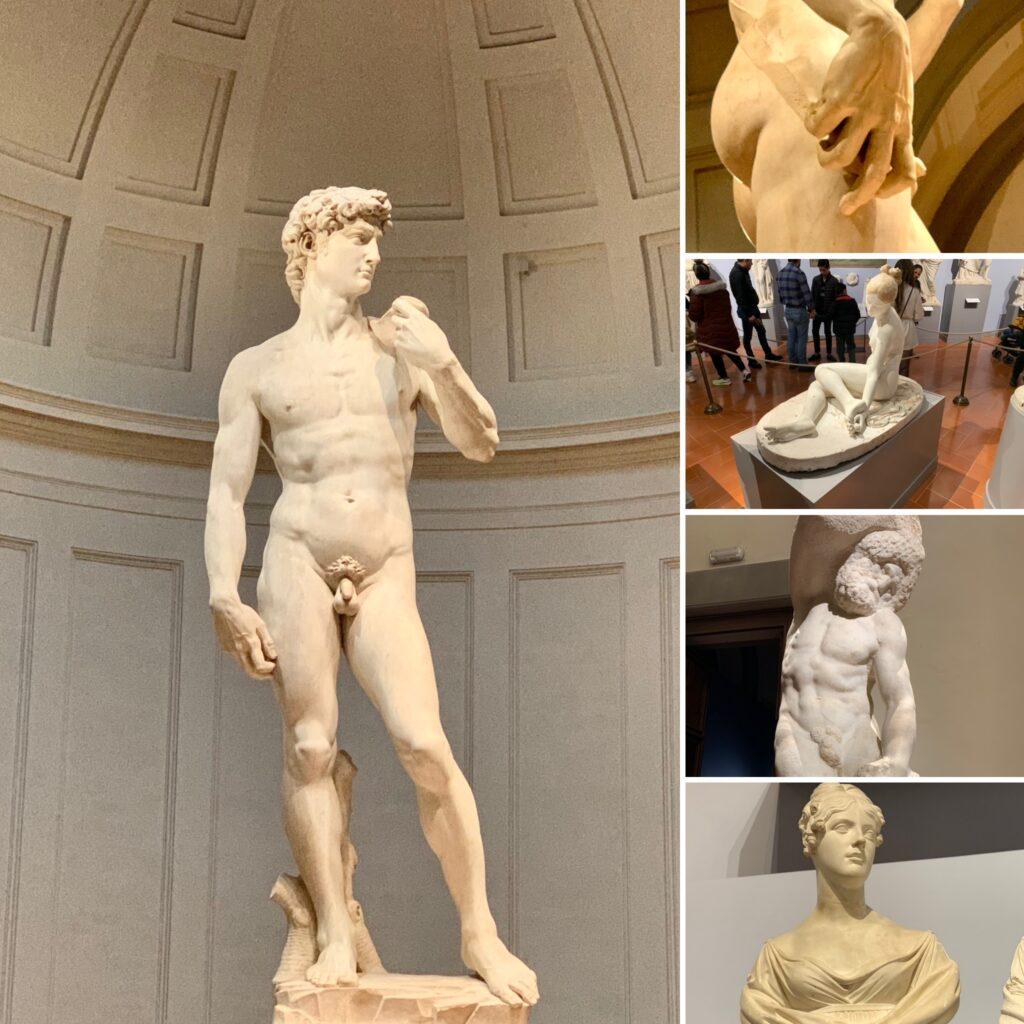
The Accademia Gallery in Florence is home to many famous works of art. Michelangelo’s David is the centerpiece of the Accademia Gallery, and it’s one of the most iconic works of art in the world. The sculpture is over 17 feet tall and depicts the biblical hero David.
Michelangelo’s David is widely regarded as one of the most beautiful sculptures ever created. The statue is also a powerful symbol of Florence’s independence and strength. The statue was commissioned in the early 16th century as a symbol of the city’s resistance to outside threats.
Michelangelo’s David is a masterpiece of sculpture not only because of its beauty and symbolism, but also because of the incredible technical skill required to create it. The statue was carved from a single block of marble, and Michelangelo’s skillful use of light and shadow creates a sense of movement and tension in the sculpture.
Open Hours: Tue – Sun 8:15 am to 6:50 pm (last admission at 6:20 pm)
Close Days: every Monday, January 1, and December 25.
Ticket Office: https://www.galleriaaccademiafirenze.it/en/tickets/
Ticket Price: Full / Reduced: €12 / €2 + online reservation €4
Recommend reserving the ticket as lines can be long.
Ponte Vecchio
Take a stroll across the iconic Ponte Vecchio, and enjoy the stunning views of the Arno River. As you walk across the bridge, take some time to explore the artisan shops and boutiques that line the streets.
Ponte Vecchio is a unique and beautiful bridge, with its two-story structure and shops built into the sides. It’s also known for its three arches, which are made of stone and span across the River Arno.
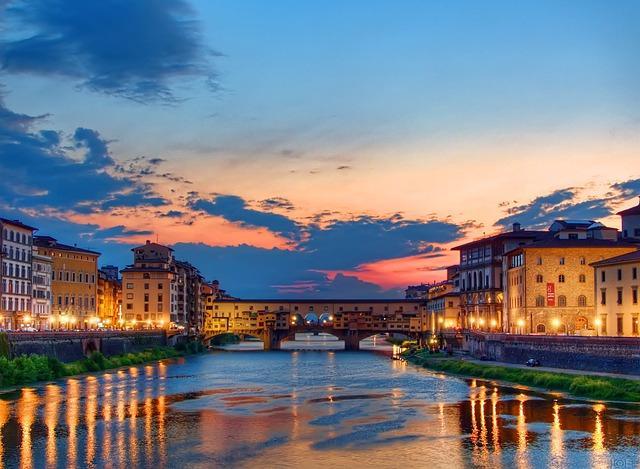
Ponte Vecchio is one of the oldest and most historic bridges in Florence. It dates back to medieval times and is the only bridge in Florence to have survived World War II intact.
Open Hours: 24 hours
No Ticket, free to visit.
Palazzo Vecchio and Piazza della Signoria
Piazza della Signoria is one of the most famous public squares in Florence. This historic square is home to many important landmarks and works of art, and it’s a must-visit destination for anyone traveling to Florence.
The centerpiece of the square is the Palazzo Vecchio, a large fortress-like palace that was the seat of government in Florence for centuries. Today, it’s a museum that’s open to the public for tours.
In the center of the square, you’ll find the Fountain of Neptune, a large and impressive fountain that features a statue of Neptune, the Roman god of the sea. The fountain is a popular spot for taking photos and admiring the intricate details of the sculpture.
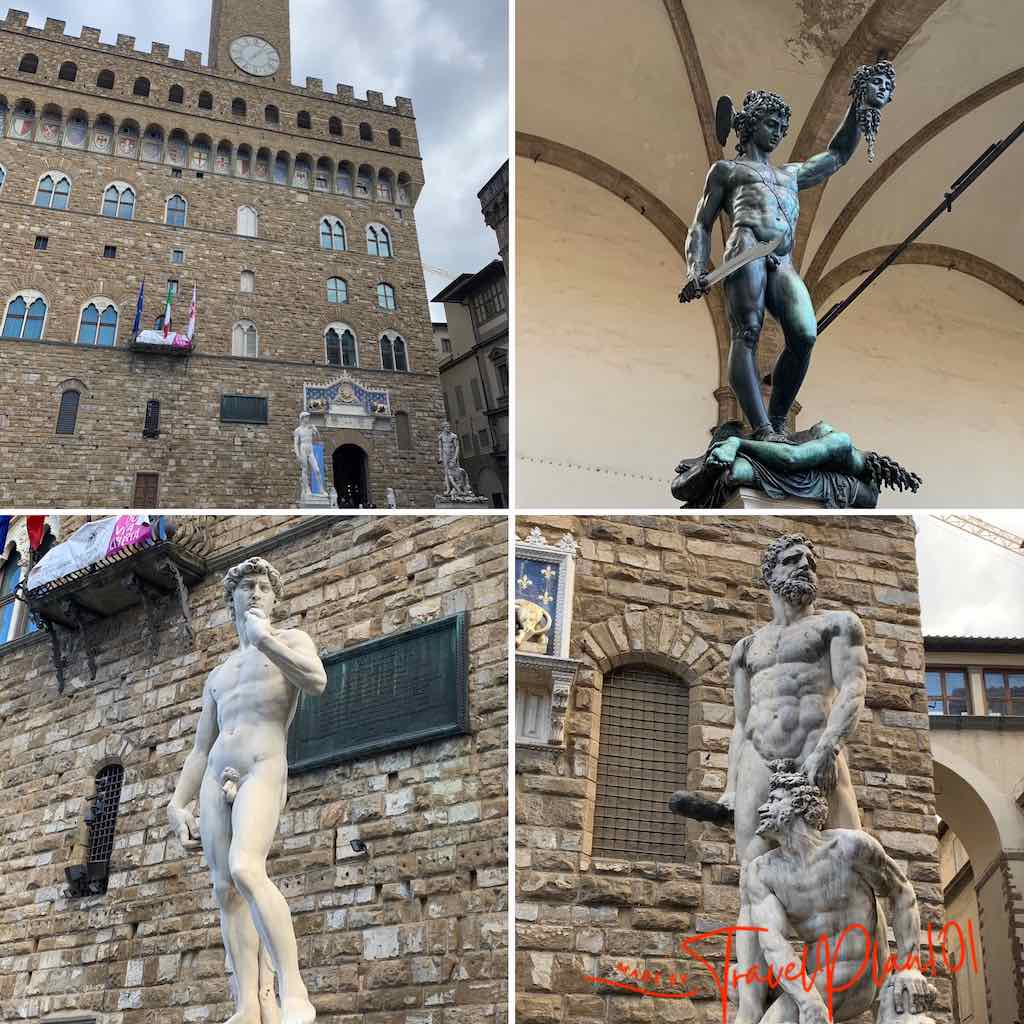
Adjacent to the Palazzo Vecchio is the Loggia dei Lanzi, an open-air sculpture gallery that’s home to many important works of art. Here, you can see sculptures like the Perseus with the Head of Medusa by Benvenuto Cellini and the Rape of the Sabine Women by Giambologna.
Another famous sculpture that can be found in Piazza della Signoria is a copy of Michelangelo’s David. This statue is located in front of the Palazzo Vecchio and is a popular spot for taking photos and admiring the artistry of the sculpture.
Open Hours: 24 hours
No Ticket, free to visit.
Basilica di Santa Croce
The Basilica di Santa Croce, also known as the Holy Cross Basilica in English, is the largest Franciscan church in the world. It was built in the 13th century and contains 16 chapels. The basilica is the final resting place of many famous figures such as Michelangelo, Galileo, Machiavelli, Rossini, and others.
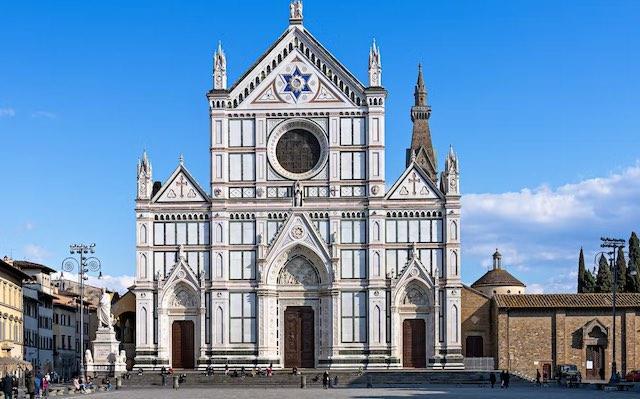
Bargello National Museum
The Bargello Museum, is the second-ranking museum after the Uffizi in Florence. The Bargello Museum is located in the impressive Palazzo del Bargello. Originally a palace and a prison, today The Bargello is a museum that houses some of the most important sculptures in the world.
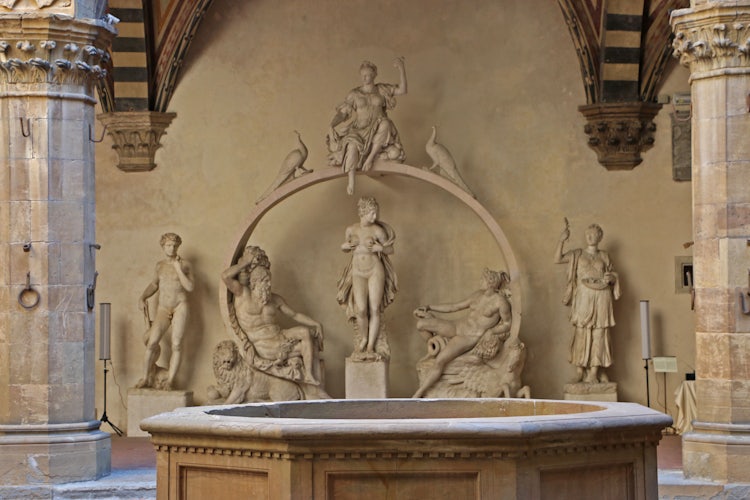
One of the highlights of The Bargello is Donatello’s David sculpture, which is widely considered one of the greatest sculptures of the Renaissance. The sculpture is known for its innovative use of perspective and its emotional expressiveness.
Another famous sculpture that can be found in The Bargello is Michelangelo’s Bacchus. This statue is one of the earliest works by the great artist and showcases his incredible skill and attention to detail.
Open Hours:
- Mon, Wed – Sunday: 8:15 am – 1:50pm
- Sat: 8:15 am – 6:50pm
- Tue close
- Ticket office closes at 1:20pm, museum starts closing at 1:40pm
Ticket Price: Full / Reduced: €8 / €2
Medici Chapels
The Medici Chapels are a testament to the family’s patronage of art and their desire for a grand final resting place. The chapels consist of the New Sacristy, designed by Michelangelo, and the larger Chapel of the Princes, an opulent mausoleum adorned with precious stones and intricate decorations. A visit to the Basilica di San Lorenzo and Medici Chapels offers a fascinating insight into the interplay between power, art, and religion in Renaissance Florence.
Open Hours:
- 8:15am – 6:50pm Mon and Wed- Sat
- 8:15am – 1:50pm Sun
- Close Tue
Ticket Office: https://www.florence-museum.com/medici-chapels-tickets.php
Not necessary to pre-order the ticket.
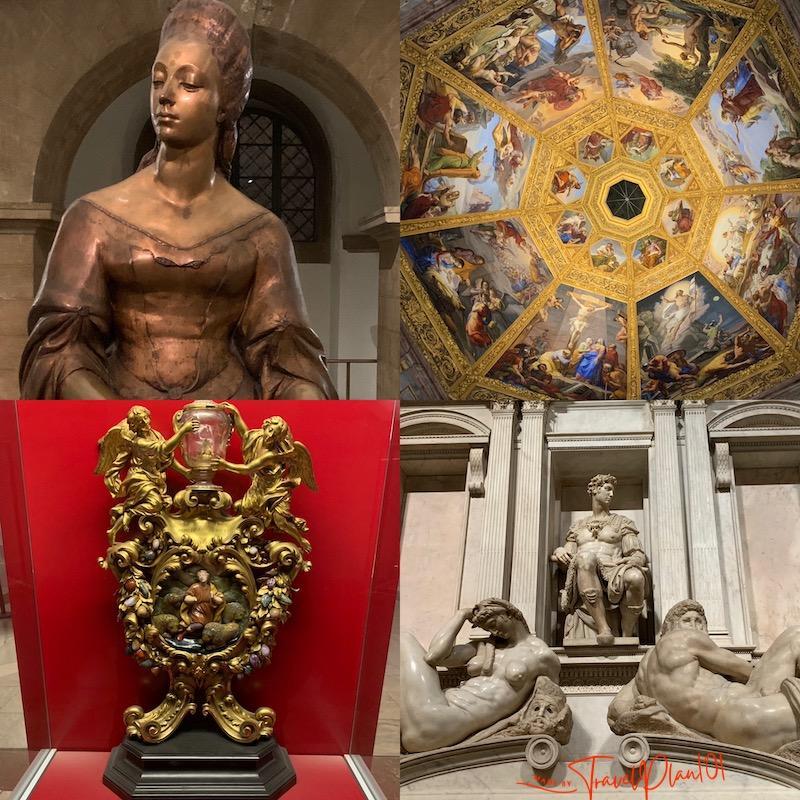
Piazzale Michelangelo
The Piazzale Michelangelo is a panoramic terrace with views of Florence and the Arno River. It is a popular spot for taking photos of the whole city.
Tips: Be careful about the pocket-picking in the plaza. Especially during sunset time, the plaza can be very crowded.
Free entry. No ticket is required.
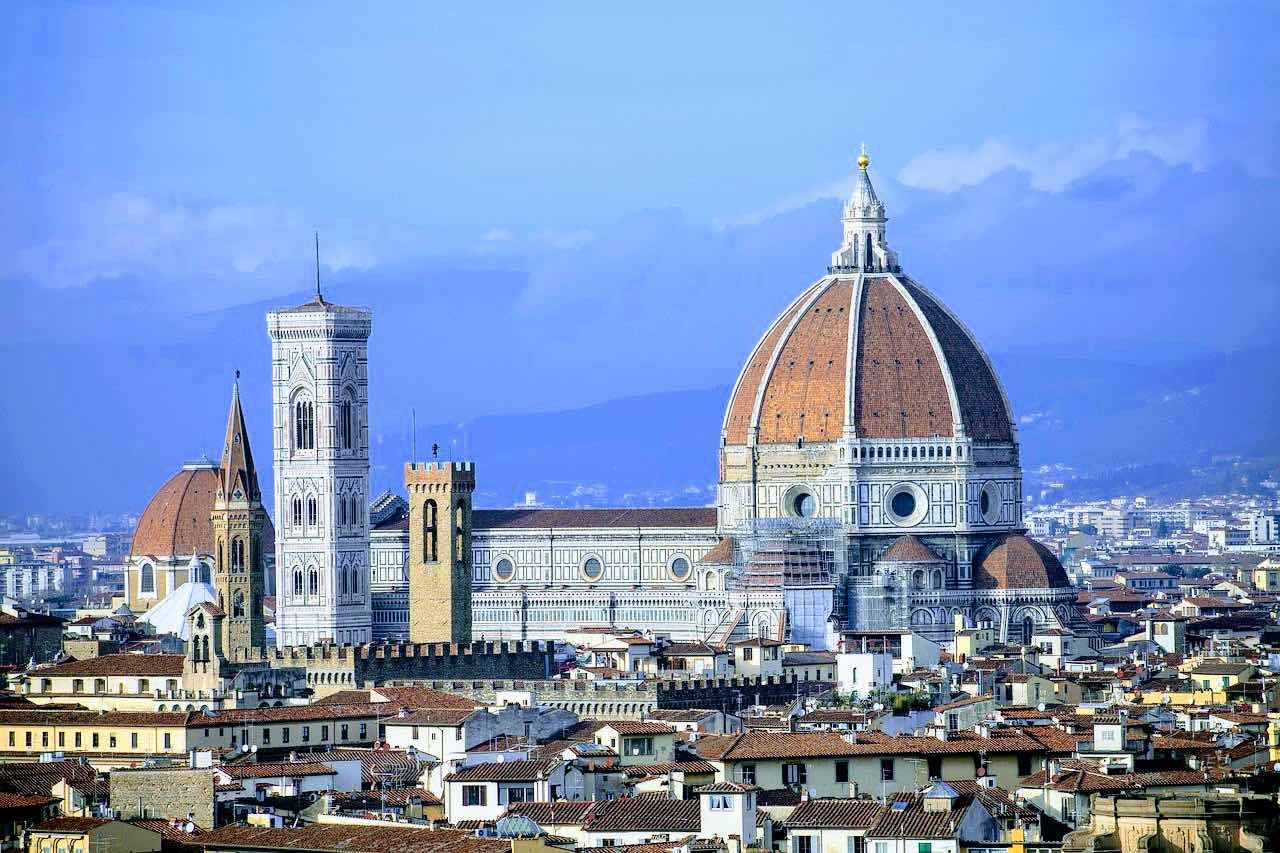
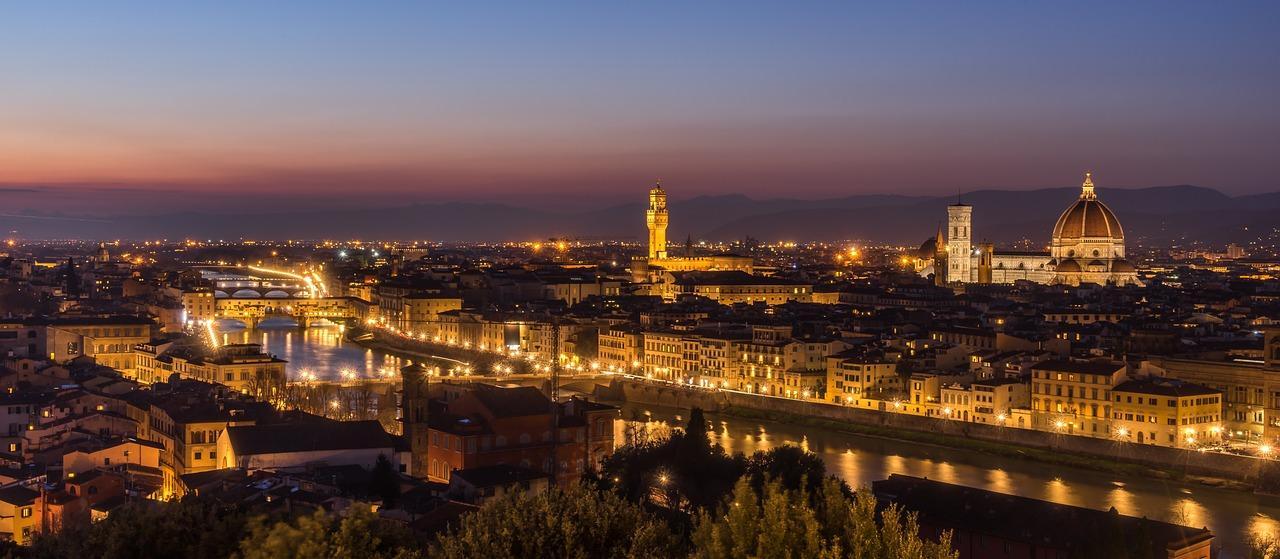
Suggested Itineraries for Florence
One-day Itinerary in Florence
Morning:
- Start your day by visiting the Piazza del Duomo, where you can admire the Cathedral of Santa Maria del Fiore (the Florence Cathedral), the Baptistry of San Giovanni, and Giotto’s Bell Tower.
- Climb to the top of the dome or Giotto’s Bell Tower for stunning views of Florence.
- Visit the Museo dell’Opera del Duomo, which houses various artifacts and artwork from the Cathedral.
Afternoon:
- Head to Piazza della Signoria, the heart of Florence’s historic center, and marvel at Palazzo Vecchio, Loggia dei Lanzi, and the Fountain of Neptune.
- Explore the Uffizi Gallery, one of the world’s most famous art museums, showcasing works by Michelangelo, Botticelli, da Vinci, and more.
- Walk across the iconic Ponte Vecchio, a medieval bridge lined with jewelry shops.
Evening:
- Take a leisurely stroll along the Arno River to Piazzale Michelangelo, where you can enjoy panoramic views of Florence at sunset.
- Return to the city center and enjoy a traditional Tuscan dinner in a local trattoria.
Two-day Itinerary in Florence
Day 1: Follow the 1-day itinerary mentioned above.
Day 2:
Morning:
- Visit the Accademia Gallery, home to Michelangelo’s David and other significant works of art.
- Explore the Basilica of San Lorenzo and the adjacent Medici Chapels, both important sites for Florence’s history and art.
Afternoon:
- Discover the beautiful and vast Pitti Palace, which houses several museums and galleries.
- Relax and wander through the enchanting Boboli Gardens, located just behind the Pitti Palace.
Evening:
- Stroll through the Oltrarno neighborhood, known for its artisan shops and vibrant nightlife.
- Enjoy a delicious dinner at a local osteria, and consider catching a live music performance or visiting a wine bar.
Three-day Itinerary in Florence
Day 1 and Day 2: Follow the 2-day itinerary mentioned above.
Day 3:
Morning:
- Visit the Church of Santa Croce, the final resting place of many famous Italians, including Michelangelo, Galileo, and Machiavelli.
- Explore the nearby Bargello Museum, which houses an impressive collection of Renaissance sculptures.
Afternoon:
- Head to the Palazzo Medici Riccardi, a splendid example of Renaissance architecture and the former residence of the powerful Medici family.
- Visit the San Marco Museum, a former Dominican convent that now displays frescoes by Fra Angelico and other religious artworks.
Evening:
- Take a walk in the charming Piazza Santo Spirito, where you can find local markets and various dining options.
- Enjoy a final dinner at one of the many excellent restaurants in the area, and consider trying some Florentine gelato for dessert.
Where to Stay in Florence
When choosing a place to stay in Florence, consider your budget, personal preferences, and travel itinerary. Look for hotels or accommodations with good reviews, secure entry systems, and 24-hour reception or security. Book your stay in advance, especially during peak tourist seasons, to secure the best rates and availability.
Consider staying in the following neighborhoods and areas:
- Centro Storico (Historic Center): This area includes popular sites like the Duomo, Uffizi Gallery, and Ponte Vecchio. Staying in the historic center allows you to easily walk to most attractions, and there are plenty of hotels, restaurants, and shops to choose from. As a popular tourist area, it is generally safe, but be aware of pickpockets and practice usual safety precautions.
- Santa Maria Novella: This neighborhood is close to the main train station (Firenze Santa Maria Novella), making it convenient for travelers arriving or departing by train. The area is home to several attractions, including the Basilica di Santa Maria Novella and the Mercato Centrale. There is a wide range of accommodation options, from budget to luxury hotels, and it is generally a safe area.
- San Marco: San Marco is a quieter neighborhood, close to the historic center, with attractions like the Galleria dell’Accademia and San Marco Museum. This area offers a more relaxed atmosphere while still being within walking distance of major sites. San Marco has a variety of accommodation options and is considered safe.
- Oltrarno: Located across the Arno River from the historic center, Oltrarno is known for its artisan shops, local restaurants, and vibrant nightlife. Key attractions include the Pitti Palace, Boboli Gardens, and the Brancacci Chapel. This neighborhood offers a more authentic Florentine experience and is generally safe, though it’s essential to exercise usual safety precautions, especially at night.
Remember to always practice general safety tips, such as not displaying valuables, using a secure bag, and being aware of your surroundings, regardless of which neighborhood you choose to stay in.

